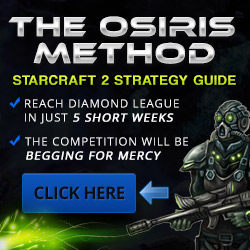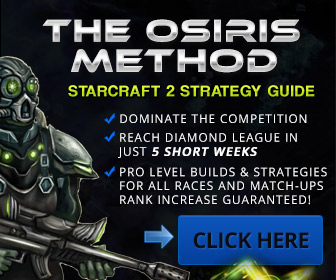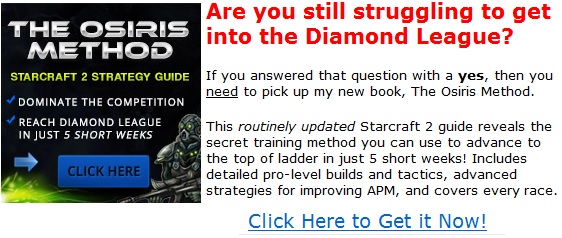Starcraft 2 Beginner's Guide
After we cover the basics, the beginner's guide will focus on how to actually win games of Starcraft 2, when to attack your opponent, and finally the next steps you can take towards improving your Starcraft 2 skills. Table of Contents Before jumping into this Starcraft 2 beginner's guide, here are a few things you should know if you are brand new (if you have already played a few games, skip this next paragraph): In a game of Starcraft 2, the goal is to kill the other person's buildings. To defeat the enemy, you need to have your workers get resources, build new structures, and finally train units. Once you have enough units, you can attack the enemy. As soon as one player loses all his buildings, the game ends (regardless of any units left in play). Building Up Your Economy & Understanding SaturationIn order to fund your "war effort", you need to use your workers (SCVs, Drones, Probes, MULEs) to harvest minerals and vespene gas. Typically players train many workers over the course of a long game, as more workers will lead to more resources which can contribute to larger armies and enhanced production. However, many beginners soon discover that workers and new expansions cost money and this investment does not necessarily always pay off. If you build nothing but workers, whereas your opponent builds a few early units and attacks, you will not have anything to defend yourself. It takes a worker about 1 minute to pay for its own production cost, so each time you train a new worker, your army is slightly inferior over the next 1 minute as it could have been if you used those same resources on units. Additionally, a worker will only pay for itself in about 1 minute if the mineral nodes are not already saturated. Saturation is the idea that as you produce more workers to mine the same mineral nodes, the workers are not able to harvest as quickly, as they are waiting in line for the worker in front of them to finish before they can start mining. Partial saturation occurs when a mineral field has on average more than 2 workers but less than 3 workers. Once you begin to begin to add workers beyond 2 harvesters per node, you get diminishing returns due to partial saturation. For example, on an expansion with 8 mineral nodes, you will see a very similar increase in mining rate for each worker you add up to 16 workers (2 per node). There is very little downtime where a mineral field is not being mined from when there are 2 workers at each mineral patch. This is because while one worker is returning their cargo, the other one is mining. There is only a second or two of downtime with each trip, since returning with the mined mineral takes slightly longer than it does to actually mine the mineral. From here, imagine if you started adding more workers to the mineral field. By going from 16 to 20 workers, there is now an average of 2.5 workers per mineral field. These extra workers will move all over the place, trying to find the 1-2 second gaps left in return trips of the original workers. A lot of these new workers' movements will be wasted, as they are not actually mining when they are jumping from mineral patch to mineral patch trying to catch the gaps. Due to this wasted movement, adding on extra workers beyond 2 per node will increase your harvesting rate, but not by much. Each additional worker up to 3 per node will offer less and less returns. What I mean by this is going from 16 to 17 workers per node at an 8 node expansion still offers a decent increase in mining production, but going from 23 to 24 is hardly noticeable. A mineral patch is fully saturated when there is 3 workers harvesting at that location. This means that there is always a worker harvesting at a patch - there is absolutely no downtime in between trips back to the Nexus or Command Center where a mineral patch is sitting unmined. When a base is fully saturated, adding additional workers does not result in any increase in the rate of minerals mined. Unless you are planning to move those workers to a new expansion in the near future, there is no advantage to having more than 3 workers per node at a given base. When Does Saturation Occur? At standard maps, full saturation of the mineral field occurs at 30 harvesters. There could be 24 harvesting minerals and 6 harvesting gas. However, some of those workers harvesting minerals (especially once you get to 2.5+ workers per mineral node) are contributing, but not much. In an ideal scenario, 48 workers harvesting minerals would be best split across 3 bases, using 16 on minerals at each base. This would result in much more income per minute than using 48 workers on minerals at 2 bases to fully saturate the two bases. This inefficiency does not mean you should not produce harvesters if a base is already partially saturated. Unless you are going for a specific rush or are being rushed, you should never stop producing workers until you have hit maximal saturation. Once you secure an expansion, you can move the workers beyond optimal totals over to your new expansion, resulting in an instant income increase. Other Things to Know About Saturation There are a few things you ought to know about to improve your mastery of saturation.
Understanding Unit DamageThe next thing a beginner needs to know about Starcraft 2 is how unit damage is calculated. This will give you much better insight into the strengths and weaknesses of each unit in Starcraft 2. "Damage" does not describe a unit's damage entirely and is a misleading stat. Some units get multiple hits per attack. For example, the Thor's Explosive Payload anti-air attack is actually 4 attacks. Where it says 6 damage per attack, it really means 24 total damage (4 attacks x 6 damage per attack). Units that have multiple attacks per animation are usually easy to spot based on their animation. For example, when the Phoenix strikes, it has two laser beam shots rather than a single shot. The Phoenix also has two attacks. Rather than guess though you can see the exact number of attacks by mousing over the weapon icon when selecting a particular unit. The damage of a multiple attacks is applied against armor one time for each attack. Take the Phoenix for example - it has two attacks, each one dealing 5 damage. When the Phoenix attacks a unit with armor, each of its attacks damage is reduced by the armor amount. If you are going against a Corruptor with +2 armor, instead of the armor just taking 2 damage off of the Phoenix's 10 total damage, that 2 damage mitigation provided by armor is taken off of both attacks. The Phoenix's damage dealt will be reduced from 2 attacks of 5 damage to 2 attacks of 3 damage. This means the Phoenix will only deal 6 damage to the Corruptor per attack cycle. Also, different units do not attack at the same speed. The Hydralisk may appear to do similar damage to a Stalker since a only deals 12 damage per attack to the Stalker's 10 (14 vs armored) and a Hydralisk also has a lot less HP. However, the Hydralisk attacks every .75 seconds (12 damage / .75 seconds = 16 damage per second). The Stalker only attacks every 1.44 seconds (10 damage / 1.44 seconds = 6.944 damage dealt for each second attacking a normal unit and 14 damage / 1.44 seconds = 9.69 damage dealt per second versus armored units). In reality, the Hydralisk deals more than twice as much damage as the Stalker despite having similar "damage" rankings! You can calculate damage per second by dividing damage dealt by attack speed - the DPS of a unit is a more accurate representation of its firepower. Unit Damage Bonuses Some units in Starcraft 2 deal bonus damage to different unit types, making them good counters versus specific units. Here are some common units and their bonuses: Marauder: +10 damage versus armored units As a result, the Marauder and Immortal are great versus armored units, while the Hellion, Thor, and Phoenix are great versus light units. You can check whether or not a unit does bonus damage by mousing over the attack icon when selecting that unit in-game. Learning Unit CountersDue to differences in mechanics as well as bonus damage modifiers, different units in Starcraft 2 have different strengths. If Unit "A" is strong against Unit "B", Unit "A" is said to counter Unit "B". For example, the Colossus is strong against the Marine, so the Colossus is considered a counter to the Marine. Since Starcraft 2 has been out for awhile, practically every player in the Platinum League or above already know all the unit counters (whether or not they act on those counters is a different story). Since a lot of players already understand counters, you must know how to construct an army that is effective against your opponent's unit choices just to remain competitive! There is more to unit counters than damage alone. Mechanics also have to be considered. For example, the Stalker counters the Marine in the early game, because the Stalker has a larger range and a faster movement speed. When well microed (controlled), the Stalker can kill multiple Marines Marine without actually taking damage. I have created two counters charts for each race that you can use to quickly memorize all the counters in Starcraft 2. You can find those in our Starcraft 2 Unit Counters list. Other Important Game Terms and ConceptsLearning how to build up a decent economy and learning unit counters is just the beginning of the practice you will need to rise to the top of the ranks in Starcraft 2. Mastering those basics might get you out of the Bronze league, but it will not get you much higher. In this section, we cover some other important game terms and concepts.
How to Win Games of Starcraft 2While the information up until this point of the beginner's guide was very important, you need to learn these concepts just to have a chance to win online games. We have not even touched on the heart of the matter: how to win games of Starcraft 2. Starcraft 2 games (especially at the high level) are rarely won in a single battle. Rather, one player performs a series of attacks, one building upon the other, until they have built a large enough advantage to win the game. This is necessary due to defender's advantage. Each race has small advantages when on defense. Protoss has Photon Overcharge, Zerg has the creep movement speed bonus, and Terran have Bunkers and Supply Depots, as well as the time to place tanks in optimal positions. All players on defense of being able to take the advantage of choke points and high ground when defending their main base and natural, but typically the third or fourth base does not offer this sort of protection. In an evenly-matched game, top tier players will attack these less defendable positions, building an advantage until they are able to take out the opposing player head-on. For example, take a look at the Terran vs Zerg match-up. When the Terran wants to attack the Zerg player, there is a big defender's advantage for the Zerg player because Zerg units move faster on creep. This makes it easier for the Zerg to surround the Terran's forces with Zerglings or connect with a big Baneling hit. A Terran player may be completely in control of the game and have a superior force, but not necessarily large enough to overcome the creep advantage. Trying to take out the Zerg in one big attack is dangerous, because if the Zerg effectively uses Banelings and Infestors, the Terran could quickly lose their entire army. Since the Zerg can remacro faster than Terran, the Terran could lose the game outright to the Zerg's reinforcement wave. It is much easier to deny the Zerg player a fourth or fifth base, constantly attacking this Hatchery as soon as it goes up. The Terran player can attack these satellite bases, using drops and little attacks, inflicting some damage each time. Eventually, the Zerg will mine out their main and natural expansion and without a fourth or fifth base, will not have the resources they need to keep pace with a Terran that has taken multiple expansions. Once the Terran bleeds the Zerg's economy down to a small income, the Terran is then able to engage the weakened Zerg army head on, creep or no creep. Please remember that this Terran vs Zerg strategy is an advanced tactic, but the principle applies. Namely, you need to take advantage of any time you can get an advantage over the enemy player with an attack (often referred to "getting ahead" in a game). Here are a few examples:
When is the Best Time to Attack?When it comes to finishing games in Starcraft 2 and locking up a victory, you have to be able to accurately determine whether or not there is an opportunity for your forces at any given time can overcome the opponent's and win the game. Some top players advocate always trying to roll small advantages into larger ones and only trying to win the game once you are sure you have a big enough advantage to take down your opponent with almost all certainly. Other players try Like many things in Starcraft 2 as well as life in general, there is no absolute answer about who is right or wrong. Different players have different playstyles, and successful pros come from both schools of thought. I recommend making a calculated risk. If you are 90% (or even 80%) sure you can win the game with an all-in attack, I would recommend going for the win if you are playing on the ladder and just trying to increase your ranks. Remember that a 70% win-rate on the ladder over an entire season is considered an excellent win-rate. If you win 70% of your games and play 500 games in a ladder season, you will be in the Master's League at a minimum (if you have a 70% win rate on 10 games, it does not count). The longer a game goes on, the more time your opponent has to find a way to get back into the game. When you have a great shot at winning, you should take it. On the other hand, sometimes an early advantage is not enough to turn into a reliable win. If you had a successful opener, inflicting a lot of economical damage, but losing a lot of your army in the process, you might need to sit back on your superior economy until you can produce a much large army than your opponent has. Learning how to calculate your chances of winning at any given time is a skill you pick up over time. A lot of this will come down just to trial and error. Make sure you watch your replays after each game for immediate feedback. Whenever you are watching a replay, you should always have the following question in the back of your mind: If one player attacked another right now, does either player have a big enough advantage to win the game? Oftentimes over the course of a 30 minute game there are several instances where one or both players could have won the game with an all-in attack. What to Do Next to Master Starcraft 2?If you are a beginner at Starcraft 2, your first step is to master the concepts mentioned in this beginner's guide. Place special emphasis on learning the hotkeys and improving your APM, as being able to interact efficiently with the game is necessary to not only be successful at Starcraft 2, but also helps you learn the other aspects of the game faster. If you are constantly fumbling around looking for keys or clicking things, you will never be able to dedicate much attention to the finer details of the game! Once you have those basics covered, start digging into specific builds and strategies for the race of your choice. Take some time to watch your replays and be sure to check out some replays of professionals so you can see their strategies and tactics. Observing the way pros play Starcraft 2 is one of the most important training practices in Starcraft 2. If you want a step-by-step training program designed to teach high-level Starcraft 2 skill in the shortest amount of time possible, check out my book, The Osiris Method. |
Don't be shy - share this page on G+ and Twitter!
Sign up for my Free Starcraft 2 Mini-Course where I reveal my best strategies not seen anywhere on this site!
Starcraft 2 Strategy Guide Privacy Policy Contact Us Disclaimer
©2013 www.osirissc2guide.com


